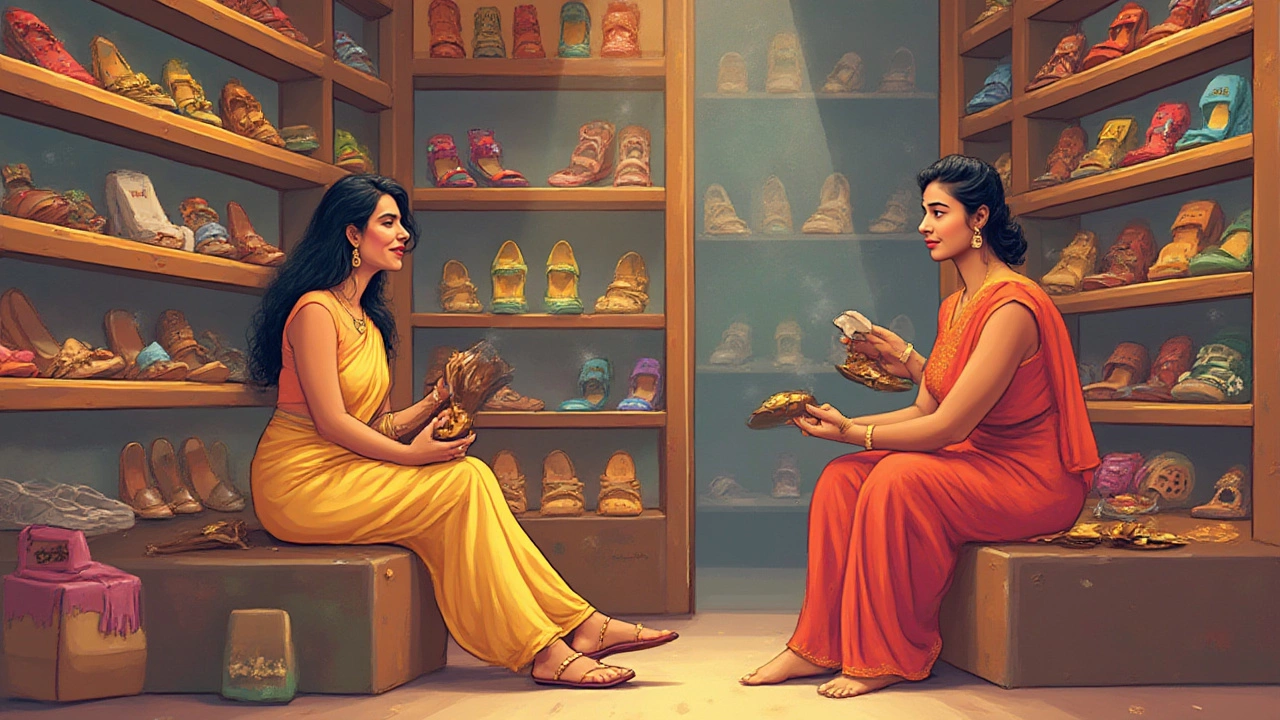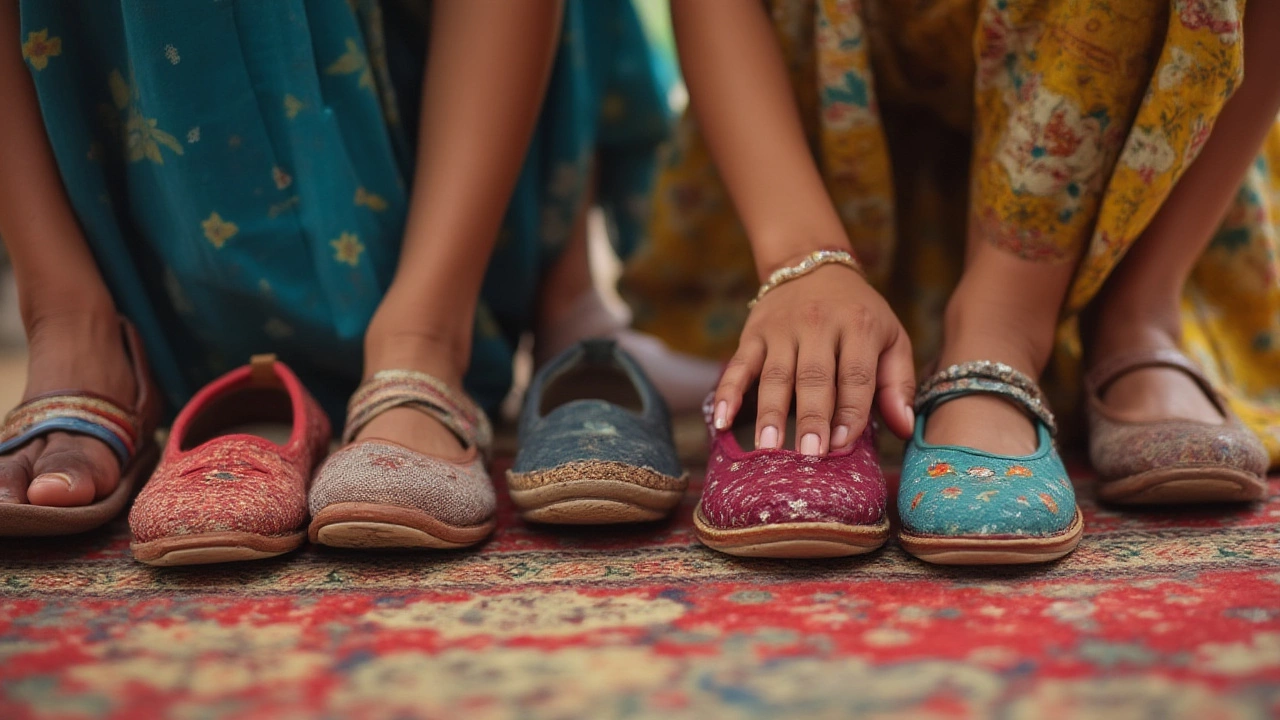Ever left a shoe store convinced the right size must be lost in a parallel universe? There’s a reason you sweat over half sizes—footwear sizing isn’t a trivial detail. Half a shoe size, just 4.23 millimeters in length, might seem like a blip. But that tiny shift can mark the line between walking tall and limping through the day. People hardly talk about how a half size ruins or transforms comfort; it's a sort of secret handshake among chronic shoe returners. If you’ve ever felt like Goldilocks in the men's or women’s shoe aisle—not too big, not too small, but rarely just right—you know the agony of not quite fitting into those perfectly styled kicks.
What Does 0.5 Shoe Size Actually Mean?
You’d think half a size just means 'almost right.' But let’s bust that myth wide open. In American sizing, each full size is about 8.46 millimeters (or a third of an inch). That means a 0.5 shoe size is just half that—around 4.23 millimeters. It barely shows up on a ruler, but your feet know the difference the moment you slip them in. Brands like Adidas or Nike use EU sizing behind the scenes, where the jump between sizes is even weirder—about 6.67 millimeters per EU increment.
It’s not just about length, though. Shoe sizes also account for width. Shoe makers often increase both length and girth as sizes go up, but not always consistently. That’s why some size 9s by New Balance feel roomy while others from Adidas might squeeze like a vice. Sometimes it seems shoes have their own hidden language and you need Rosetta Stone to decipher it!
Here’s a quick look at what 0.5 of a size looks like in common shoe sizing systems:
| System | Full Size Difference (mm) | Half Size Difference (mm) |
|---|---|---|
| US | 8.46 | 4.23 |
| EU | 6.67 | 3.33 |
| UK | 8.47 | 4.24 |
But don’t freak out if you own shoes labeled in all three—most brands cut and finish shoes by their own molds. So, while the nominal half-size jump makes sense on paper, in real life it’s subject to design choices and country quirks. It’s not rare for someone to wear a US 9 in one style but need a 9.5 or even 10 in another.
And it gets wilder: there’s actually no legal or industry mandate forcing brands to stick to these increments! Each company’s idea of a '9' or a '9.5' can shift by a millimeter or two. So when your feet feel that 0.5 difference, they’re catching on to more than just size—they’re revealing details designers won't advertise.
Science Behind the Half-Size: Foot Anatomy and Comfort
You’d be surprised how many moving parts go into shoe size beyond just the number on the box. First, let’s talk about feet. They don’t just differ wildly from person to person—they change based on weather, weight, and even the time of day. Wake up in the morning and your feet might be half a size slimmer than they’ll be at night, thanks to gravity and fluid shift.
Not only that, but research from the American Podiatric Medical Association found that up to 72% of people wear the wrong shoe size—often just because they shrug off the tiny annoyances when trying shoes in-store. Ever catch yourself thinking 'eh, it’s a little snug, but it’ll stretch'? That’s how blisters and corns sneak up on you.
Even the way you walk—your pronation, arch height, and toe splay—adds yet another layer. Two guys with the same 10.5-size foot might prefer completely different fits if one leans heavily on his big toe and the other stays more neutral. The fact is, slipping on a shoe that's even half a size off can lead to bruised toes, awkward gait, and the kind of soreness that makes you regret every step.
Doctors see it all the time: just a few millimeters too tight leads to bunions, black toenails (especially among runners), or cramping on long days. If you’re thinking about lifestyle—running a marathon, standing all day at work, chasing kids—those 4.23 millimeters can matter more than you’d guess. Over 80% of foot pain issues come down to 'fit problems.' Being off by less than a centimeter is enough to put someone out of commission for weeks.
The problem’s trickier if you have one foot slightly bigger than the other (and most people do—Clara’s left foot is half a size bigger than her right). Experts recommend always fitting shoes to your larger foot, which sometimes means sacrificing a perfect glove fit for one side, just to avoid damaging the other. That’s another reason why half sizes are such a game changer—they let you split the difference without needing custom-made shoes.

How 0.5 Size Feels in Real Life: Walking, Running, and Style
If you’ve ever fallen in love with a shoe only to find your size is sold out, you’ve probably done the '0.5 debate.' Will sizing up flop off your heel like a flip-flop? Will sizing down mean squeezed toes and regret after an hour?
You can absolutely feel a half-size. Walk briskly through a mall and your foot will expand a bit from heat and blood flow. If your shoes are just a hair too small, that extra 4.23 mm gap turns into a sting across your toes or a hot spot by your heel. Even for sneakers—a style thought of as forgiving—half a size too small crams your toenails, and too large creates slippage and blisters. That’s before you even get to pointed dress boots or narrow formal shoes, where 0.5 too tight can turn a work event into a torture session.
Let’s get specific. If you run regularly, you’ve probably heard the advice to size up about half a size to accommodate foot swelling. Runners in a study from the University of South Australia (2023) showed much fewer blisters and black toenails when they followed this logic—especially during marathons and half-marathons. Daily walkers or commuters tend to be fine with a precise fit, but stand-all-day professions like chefs, nurses, and retail workers often report much happier feet when they get that half-size buffer.
Fashion-wise, that 0.5 can make or break an outfit. If you cuff your jeans just right to show off a killer pair of loafers, the last thing you want is heel slippage every time you stride. On the flip side, half a size too tight and you look awkward, shuffling or popping your shoes off every chance you get. That’s why stylists and cobblers alike swear by trying shoes both in the morning and again in the late afternoon—your feet change, and the difference between snug and suffocating is more nuanced than most people think.
If you’re someone who lives in boots all winter, pay attention: half a size up may be crucial if you wear thick socks. More than one friend of mine discovered their winter boots were the culprit behind numb toes, all because they ignored that tiny number.
Tips for Finding Your Perfect Size (and When to Choose the 0.5)
Shoe shopping shouldn’t feel like roulette. Want to stop the guesswork? Here’s how to really nail your size—and when that half size will change your world.
- Measure your feet at night: Your feet swell during the day, sometimes by as much as half a size. Shop or measure in the evenings when your foot is at its largest.
- Try both feet: Measure both feet and always buy for the larger one. If you’re stuck between two sizes, the comfort and health of your bigger foot takes priority.
- Focus on width and length: Don’t just consider the number. If your toes are fighting for space sideways (think bunions or pinky toe squeezing), try wide versions or check brands that sport a wider fit, like New Balance or Clarks.
- Take socks into account: Switching from dress socks to thick athletic pairs? They can take up several millimeters, so factor that in before deciding between a snug 9 or roomier 9.5.
- Move around: Don’t just stand in new shoes—walk, run, lunge if the shop allows it! Notice any heel slippage, tight spots, or weird creasing across your toes. Real-life use tells you more than standing still.
- Pay attention to materials: Leather stretches more than synthetic mesh. Stiffer shoes (like patent leather) don’t 'give' as much, so half a size matters a lot more in those cases.
- Break-in myths: A shoe that feels iffy in-store won’t magically expand overnight. Modern shoes require less break-in than in decades past; it should fit close to perfect right away.
- Remember your life activities: Marathon runner? Restaurant worker? You might need that buffer half-size even if most of your shoes fit dead-on.
If you’re shopping online—and, let’s be honest, who isn’t these days—use brand-specific charts and pay attention to customer reviews for sizing quirks. Some brands run notoriously small (Puma, Vans); others are generous (Hoka, Birkenstock). I learned the hard way ordering boots 'true to size' from three different retailers and getting three very different fits—all labeled US 10.5 but technically between 28 and 28.8 cm in interior length.
Here’s the fix: trace your biggest foot on a blank sheet of printer paper, measure heel to big toe, and compare the result with brand-specific interior length measurements, not just size numbers. Match those centimeters up, and you’ll dodge a huge share of returns and regrets. If you’re ever on the edge between sizes, go for the bigger one. You can always add a tighter sock or an insole for a touch more snug, but you can’t make a shoe longer without professional stretching.
As for half sizes—don’t treat them as a marketing gimmick or optional. For some, it’s the line between pain and pain-free. For others, it's the edge that lets you stand all day without distraction. If you’re not already a half-size convert, give it a shot next time you shop and see if those extra few millimeters just might surprise you.

